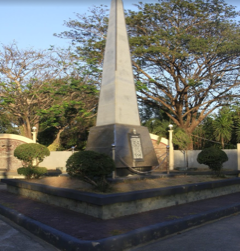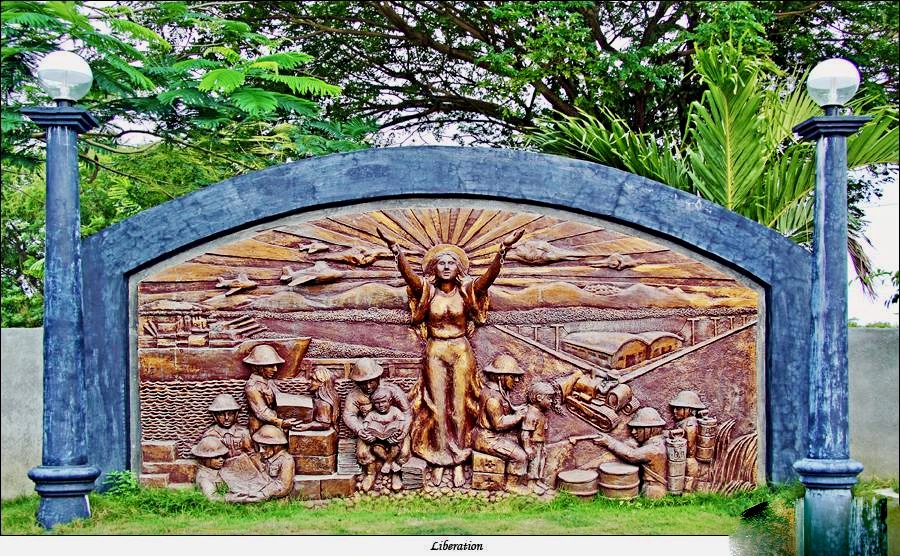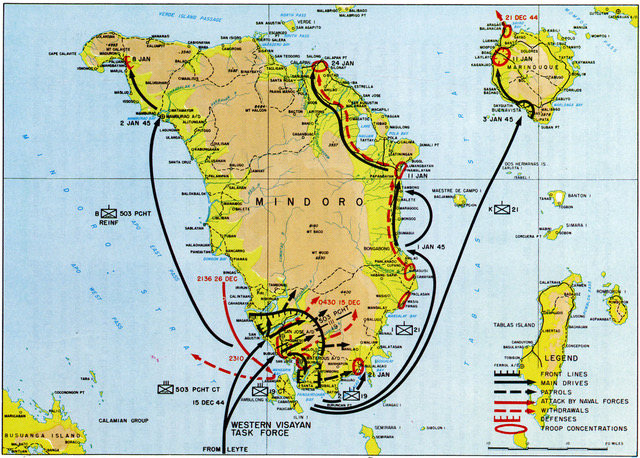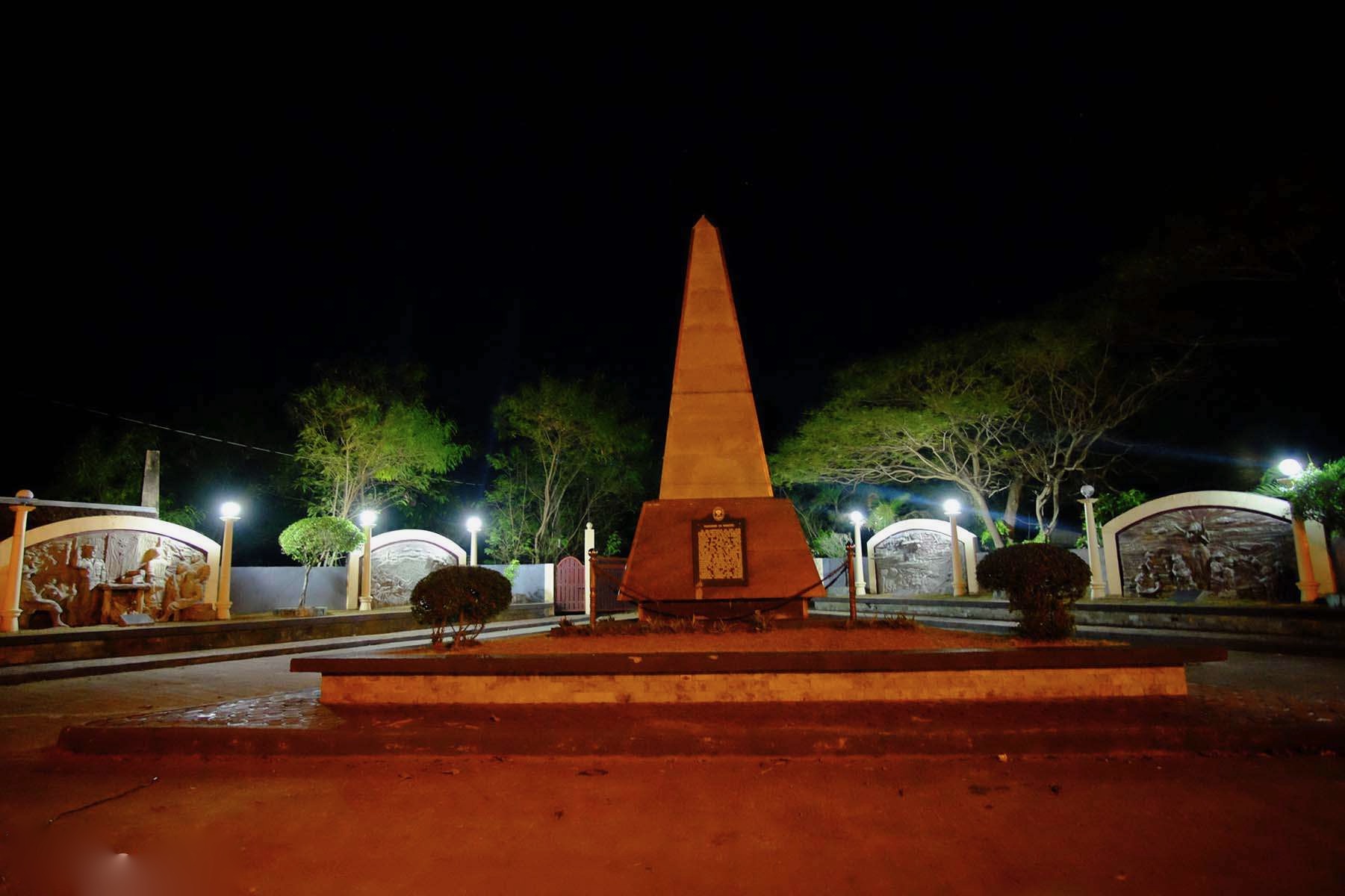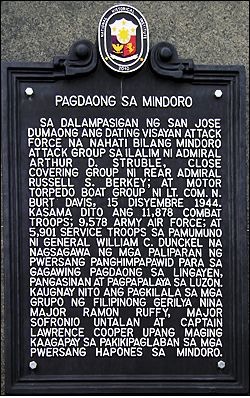Mindoro “Second Landing” Monument
Details:
Located in the center of a street intersection near the airport access road.
The monument consists of a granite marker with an explanatory plaque and three other murals which commemorate Philippine history to include their 1945 liberation.
This war memorial preserves the site of General MacArthur’s “second landing” on December 15, 1944, at the coast of Aroma Beach in San Jose on Mindoro.
Some background on the Mindoro landings from WW2 Museum Facebook page:
The Battle of Mindoro was a battle fought between the US and Japan, during the Philippines Campaign, in mid December 1944. Before American forces could consider assaulting Luzon, the largest island in the Philippines and home to the capital city Manila, advance airbases had to be established so that the troops could move under the protection of friendly aircraft. Brigadier General William Dunkel and his troops sailed for Mindoro under the protection of the Seventh Fleet by way of Surigao Strait. The landing took place on 15 December completely surprising the Japanese, who thought Negros or Panay would be the next American target, the landing was unopposed. Carrier-born aircraft circled above also nearly unchallenged, but many Kamikaze aircraft slipped through and caused considerable damage to American shipping including sinking two landing craft, though in the grand scheme of the invasion the sacrifices achieved little. By 28 Dec, two fighter bases were ready for the Luzon invasion scheduled for 9 Jan. With Mindoro lost, Japan also lost the use of Manila as a central transfer station of naval transports.
Although it is overshadowed by the prior landing in Leyte, Mindoro is actually considered as one of MacArthur's most strategic moves which paved the way for the liberation of Manila.
The attack force consisted of the following organization:
From US Army History:
The Western Visayan Task Force, which executed this operation, consisted of three groups of the US Navy arrived in Mindoro Straits in the early morning of December 15. 1944:
1) Mindoro Attack Group of R / Adm. Artur D. Struble (Task Group 77.3) (Force consisted of 8 destroyer-transports, 30 LSTs, 12 LSMs, 31 LCIs, supported by 10 large and 7 small minesweepers, 14 other small craft, and 12 escorting destroyers)
2) Close Covering Group of R / Adm. ‘Count’ Berkley (Force Consisted of: 1 heavy cruiser, 2 light cruisers, and 7 destroyers_
3) Motor Torpedo Boat under Lt. Adm. N. Burt Davis (Force consisted of 23 PT Boats)
4) Heavy Covering Group, (Force consisted of 3 older battleships and 6 escort carriers)
The Landing force was commanded by Brig. General William C. Dunckel.
Principal ground units were the 503rd Parachute Regimental Combat Team commanded by Colonel George Jones and the 19th Regimental Combat Team of the 24th Infantry Division.
Major Army Air Corps units included the 310th Bomber Wing and the 85th Fighter Wing
Landings occurred at Caminawit Point (Red Beach), San Agustin (Blue Beach) and Adela (Green Beach).
The day before the landing, Admiral Struble’s flagship, the USS Nashville (CL-43) was hit by a kamikaze killing 133 and wounding 190 including the Task Force leader, BG William Dunckel. (Dunckel still landed with the ground force the next day). Struble shifted his flag to the USS Dashiell (DD-659). While the landing was a great success, Kamikaze hits took their toll sinking and damaging many ships.
Monument Text:
The text on the monument plaque is written in Tagalog. The meaning on the of the plaque in English:
LANDING AT MINDORO
ON THIS SAN JOSE BEACH ON 15 DECEMBER 1944, THE VISAYAN ATTACK FORCE LANDED. THE FORCE WAS DIVIDED INTO THREE GROUPS: THE MINDORO ATTACK GROUP COMMANDED BY ARTHUR B STRUBLE; THE CLOSE COVERING GROUP COMMANDED BY ADMIRAL RUSSELL S. BERKEY AND THE MOTOR TORPEDO BOAT GROUP COMMANDED BY LT CDR N. BURT DAVIS SUPPORTING THE LANDING OF 11,878 COMBAT SOLDIERS; 9,578 ARMY AIR FORCE PERSONNEL AND 5,901 SERVICE SUPPORT TROOPS UNDER THE COMMAND OF GENERAL WILLIAM C. DUNCKEL, WHO WAS ALSO RESPONSIBLE FOR THE LINGAYEN LANDING AND LIBERATION OF LUZON. FILIPINO GUERRILLAS UNDER THE COMMAND OF MAJOR RAMON RUFFY, MAJOR SOFRINIO UNTALAN AND CAPTAIN LAWRENCE COOPER ALSO SUPPORTED THIS OPERATION TO DEFEAT THE JAPANESE FORCES IN MINDORO.
Commemorates:
People:
Units:
19th Infantry Regiment, 24th Infantry Division
21st Infantry Regiment, 24th Infantry Division
24th Infantry Division
310th Bomber Wing
503rd Parachute Regimental Combat Team
7th US Fleet
85th Fighter Wing
Task Group 77.3
U.S.S. Dashiell (DD-659)
U.S.S. Nashville (CL-43)
United States Army
United States Navy
US Army Air Corps
Western Visayan Attack Force
Wars:
WWII
Battles:
Musketeer III (Operations Love and Mike)
Pacific Theater
Philippines Campaign (1944–1945)
Other images :

